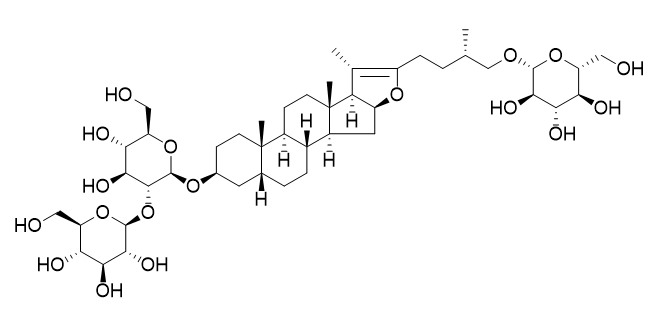Anemarsaponin B
Anemarsaponin B can inhibit PAF-induced rabbit platelet aggregation in vitro. Anemarsaponin B has anti-inflammatory effect in LPS-treated RAW 264.7macrophages, the effect is associated with the inhibition of NF-κB transcriptional activity, possibly via the p38 MAP kinase pathway.
Inquire / Order:
manager@chemfaces.com
Technical Inquiries:
service@chemfaces.com
Tel:
+86-27-84237783
Fax:
+86-27-84254680
Address:
1 Building, No. 83, CheCheng Rd., Wuhan Economic and Technological Development Zone, Wuhan, Hubei 430056, PRC
Providing storage is as stated on the product vial and the vial is kept tightly sealed, the product can be stored for up to
24 months(2-8C).
Wherever possible, you should prepare and use solutions on the same day. However, if you need to make up stock solutions in advance, we recommend that you store the solution as aliquots in tightly sealed vials at -20C. Generally, these will be useable for up to two weeks. Before use, and prior to opening the vial we recommend that you allow your product to equilibrate to room temperature for at least 1 hour.
Need more advice on solubility, usage and handling? Please email to: service@chemfaces.com
The packaging of the product may have turned upside down during transportation, resulting in the natural compounds adhering to the neck or cap of the vial. take the vial out of its packaging and gently shake to let the compounds fall to the bottom of the vial. for liquid products, centrifuge at 200-500 RPM to gather the liquid at the bottom of the vial. try to avoid loss or contamination during handling.
Food Res Int.2024, 191:114613.
J. Pharm. Res. Int.2022, 34(58): pp.1-14.
Sci Rep.2025, 15(1):29590.
Biomolecules.2019, 9(11):E696
Front Nutr.2024, 11:1409309.
Regen Biomater.2023, 10:rbad077.
J Liq Chromatogr R T2018, 41(12):761-769
Int J Mol Sci.2021, 22(21):11836.
Srinakharinwirot University2023, 2669.
Chemistry of plant raw materials2021, 1:pp 139-150
Related and Featured Products
Yao Xue Xue Bao. 1992;27(1):26-32.
[Studies on the active constituents of Anemarrhena asphodeloides bunge].[Pubmed:
1529709]
METHODS AND RESULTS:
From the ethanol extract of the Anemarrhena asphodeloides Buge (Liliaceae), a new steroidal suponin Anemarsaponin B and two known saponins anemarsaponin A1 and A2 were isolated. On the basis of chemical evidences and spectral analysis (UV, IR, EI-MS, FAB-MS, 1H-NMR and 13C-NMR), the structure of Anemarsaponin B was elucidated as 26-O-beta-D-glucopyranosylfurost-20(22)-ene-3 beta,26-diol-3-O-beta-D- glucopyranosyl(1----2)-beta-D-galactopyranoside.
CONCLUSIONS:
Preliminary pharmacological tests showed that Anemarsaponin B could inhibit PAF-induced rabbit platelet aggregation in vitro.
Planta Med. 1991 Oct;57(5):460-2.
A new active steroidal saponin from Anemarrhena asphodeloides.[Pubmed:
1798801]
METHODS AND RESULTS:
A new active steroidal saponin, Anemarsaponin B, was isolated from the rhizomes of Anemarrhina asphodeloides. The structure of Anemarsaponin B was elucidated as 26-O-beta-D-glucopyranosylfurost-20(22)-ene-3 beta, 26-diol-3-O-beta-D-glucopyranosyl-(1----2)-beta-D-galactopyranoside by chemical and spectral studies.
CONCLUSIONS:
Preliminary pharmacological tests showed that Anemarsaponin B could inhibit PAF-induced rabbit platelet aggregation in vitro.
Food Chem Toxicol . 2009 Jul;47(7):1610-7.
Anti-inflammatory effect of anemarsaponin B isolated from the rhizomes of Anemarrhena asphodeloides in LPS-induced RAW 264.7 macrophages is mediated by negative regulation of the nuclear factor-kappaB and p38 pathways[Pubmed:
19375480]
Abstract
Anemarrhena asphodeloides is widely used in traditional Chinese medicine, and is known to have anti-diabetic and diuretic effects. In this study, we evaluated the anti-inflammatory effects of Anemarsaponin B (ASB), a steroidal saponin isolated from the rhizomes of A. asphodeloides (Liliaceae), in LPS-stimulated RAW 264.7 macrophage cell line. ASB significantly and dose-dependently decreased the protein and mRNA levels of inducible nitric oxide synthase (iNOS) and cyclooxygenase-2 (COX-2). ASB also reduced the expressions and productions of pro-inflammatory cytokines, including those of tumor necrosis factor-alpha (TNF-alpha) and interleukin-6 (IL-6). Electrophoretic mobility shift assay (EMSA) and reporter gene assays revealed that ASB attenuated the LPS-induced DNA binding and transcriptional activity of nuclear factor-kappa B (NF-kappaB). In addition, it was found that pretreatment with ASB significantly inhibited the nuclear translocation of the p65 subunit of NF-kappaB by blocking the phosphorylation of inhibitory kappa B-alpha (IkappaB-alpha). On the other hand, ASB inhibited the phosphorylation of MAP kinase kinases 3/6 (MKK3/6) and mixed lineage kinase 3 (MLK3), which are both involved in the p38 pathway. Taken together, these results suggest that anti-inflammatory effect of ASB in LPS-treated RAW 264.7 macrophages is associated with the inhibition of NF-kappaB transcriptional activity, possibly via the p38 MAP kinase pathway.
Food Chem Toxicol. 2009 Jul;47(7):1610-7.
Anti-inflammatory effect of anemarsaponin B isolated from the rhizomes of Anemarrhena asphodeloides in LPS-induced RAW 264.7 macrophages is mediated by negative regulation of the nuclear factor-kappaB and p38 pathways.[Pubmed:
19375480]
Anemarrhena asphodeloides is widely used in traditional Chinese medicine, and is known to have anti-diabetic and diuretic effects.
METHODS AND RESULTS:
In this study, we evaluated the anti-inflammatory effects of Anemarsaponin B (ASB), a steroidal saponin isolated from the rhizomes of A. asphodeloides (Liliaceae), in LPS-stimulated RAW 264.7 macrophage cell line. ASB significantly and dose-dependently decreased the protein and mRNA levels of inducible nitric oxide synthase (iNOS) and cyclooxygenase-2 (COX-2). ASB also reduced the expressions and productions of pro-inflammatory cytokines, including those of tumor necrosis factor-alpha (TNF-alpha) and interleukin-6 (IL-6). Electrophoretic mobility shift assay (EMSA) and reporter gene assays revealed that ASB attenuated the LPS-induced DNA binding and transcriptional activity of nuclear factor-kappa B (NF-kappaB). In addition, it was found that pretreatment with ASB significantly inhibited the nuclear translocation of the p65 subunit of NF-kappaB by blocking the phosphorylation of inhibitory kappa B-alpha (IkappaB-alpha). On the other hand, ASB inhibited the phosphorylation of MAP kinase kinases 3/6 (MKK3/6) and mixed lineage kinase 3 (MLK3), which are both involved in the p38 pathway.
CONCLUSIONS:
Taken together, these results suggest that anti-inflammatory effect of ASB in LPS-treated RAW 264.7 macrophages is associated with the inhibition of NF-kappaB transcriptional activity, possibly via the p38 MAP kinase pathway.



